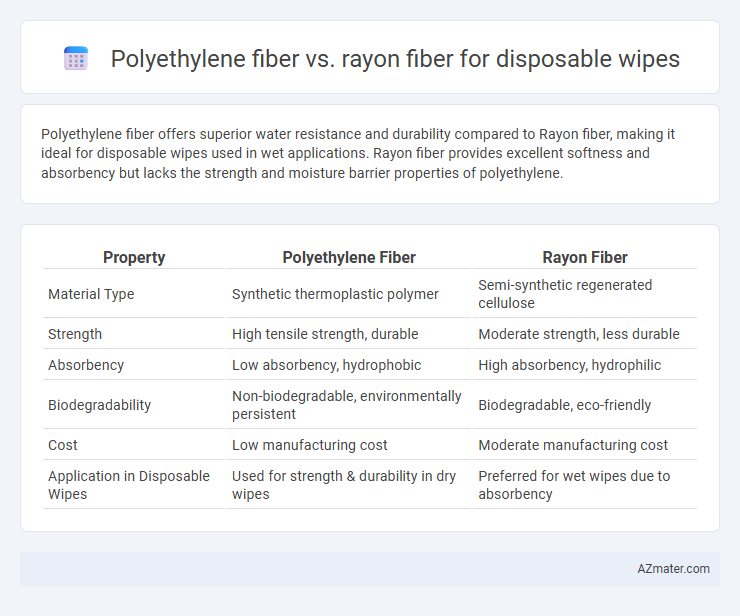Polyethylene fiber offers superior water resistance and durability compared to Rayon fiber, making it ideal for disposable wipes used in wet applications. Rayon fiber provides excellent softness and absorbency but lacks the strength and moisture barrier properties of polyethylene.
Table of Comparison
| Property | Polyethylene Fiber | Rayon Fiber |
|---|---|---|
| Material Type | Synthetic thermoplastic polymer | Semi-synthetic regenerated cellulose |
| Strength | High tensile strength, durable | Moderate strength, less durable |
| Absorbency | Low absorbency, hydrophobic | High absorbency, hydrophilic |
| Biodegradability | Non-biodegradable, environmentally persistent | Biodegradable, eco-friendly |
| Cost | Low manufacturing cost | Moderate manufacturing cost |
| Application in Disposable Wipes | Used for strength & durability in dry wipes | Preferred for wet wipes due to absorbency |
Introduction to Disposable Wipes: Polyethylene vs Rayon
Disposable wipes commonly use polyethylene and rayon fibers for their distinct properties in absorbency and durability. Polyethylene fibers offer water resistance and strength, making them ideal for cleaning tasks requiring durability and moisture barrier. Rayon fibers excel in absorbency and softness, often chosen for wipes needing gentle cleansing and high liquid retention.
What is Polyethylene Fiber?
Polyethylene fiber is a synthetic polymer made from ethylene monomers, known for its durability, water resistance, and lightweight properties, making it ideal for disposable wipes requiring strength and moisture barrier capabilities. Compared to rayon fiber, which is cellulose-based and highly absorbent, polyethylene fiber offers superior resistance to tearing and chemical substances, enhancing wipe performance in industrial and medical applications. Its hydrophobic nature prevents moisture retention, ensuring wipes remain dry until use, which is critical for maintaining hygiene and effectiveness in disposable hygiene products.
What is Rayon Fiber?
Rayon fiber, a semi-synthetic fiber derived from regenerated cellulose, offers excellent absorbency and softness, making it ideal for disposable wipes requiring gentle skin contact. It provides superior moisture retention compared to polyethylene fiber, which is synthetic and hydrophobic, often used for strength rather than absorbency. The biodegradability of rayon fiber makes it an environmentally preferable choice for disposable products over polyethylene fiber, which has limited biodegradability.
Manufacturing Process: Polyethylene vs Rayon
Polyethylene fiber for disposable wipes is produced through a melt extrusion process where polymer pellets are melted and spun into fibers, resulting in hydrophobic, strong, and durable material suitable for liquid resistance. Rayon fiber manufacturing involves dissolving cellulose in chemical solvents to create a viscous solution that is extruded through spinnerets and regenerated into fibers, yielding absorbent and biodegradable nonwovens. The melt extrusion of polyethylene offers faster production with consistent fiber properties, while rayon's chemical regeneration process provides superior softness and biodegradability but with higher production complexity.
Key Physical Properties Comparison
Polyethylene fibers exhibit superior tensile strength and chemical resistance compared to rayon fibers, making them more durable and suitable for disposable wipes exposed to harsh cleaning agents. Rayon fibers provide better absorbency and softness due to their hydrophilic nature, enhancing user comfort and liquid retention in wipe applications. The choice between polyethylene and rayon fibers depends on balancing durability requirements with absorbency and tactile properties essential for effective disposable wipes.
Absorbency and Liquid Retention
Polyethylene fiber exhibits lower absorbency but superior liquid retention due to its hydrophobic properties, making it ideal for maintaining surface moisture in disposable wipes. Rayon fiber offers high absorbency by quickly soaking liquids, but it releases liquid more readily, resulting in less liquid retention compared to polyethylene. For disposable wipes, the choice depends on whether fast absorption or prolonged liquid retention is prioritized.
Biodegradability and Environmental Impact
Polyethylene fiber, commonly used in disposable wipes, is non-biodegradable and contributes significantly to microplastic pollution, posing long-term environmental hazards. Rayon fiber, derived from natural cellulose, is biodegradable and breaks down more rapidly in natural environments, reducing landfill accumulation and ecological damage. Choosing rayon fibers for disposable wipes supports improved sustainability and lowers the environmental footprint compared to polyethylene-based wipes.
Cost Efficiency and Market Availability
Polyethylene fiber offers superior cost efficiency for disposable wipes due to its lower raw material cost and simpler manufacturing process compared to rayon fiber, which tends to be more expensive because of its cellulose-based production. Market availability of polyethylene fiber is extensive, supported by widespread petrochemical industries enabling large-scale, consistent supply, whereas rayon fiber may face supply fluctuations tied to pulp availability and processing complexities. The economic advantage and stable supply chain of polyethylene fiber make it a preferred choice for high-volume disposable wipe production in both domestic and global markets.
Applications in Disposable Wipes Industry
Polyethylene fiber offers superior water resistance, durability, and cost-effectiveness, making it ideal for heavy-duty disposable wipes used in industrial cleaning and medical settings. Rayon fiber provides excellent absorbency and softness, which enhances comfort and effectiveness in personal hygiene wipes and cosmetic applications. The disposable wipes industry often combines these fibers to balance strength and absorbency, optimizing product performance across various uses.
Which Fiber is Better for Disposable Wipes?
Polyethylene fiber offers superior water resistance and durability, making it ideal for disposable wipes that require strength and moisture retention. Rayon fiber provides excellent softness and absorbency, enhancing user comfort and effective liquid uptake in wipes. For disposable wipes, the choice depends on the application: polyethylene fibers excel in durability and wet strength, while rayon fibers deliver better absorbency and softness.

Infographic: Polyethylene fiber vs Rayon fiber for Disposable wipe
 azmater.com
azmater.com